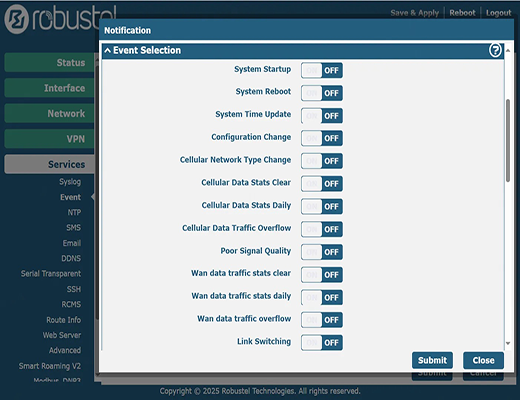
LTE Router Alert Notifications: Remote Monitoring for IoT
|
|
Time to read 5 min
|
|
Time to read 5 min
In the world of industrial IoT, an unresponsive device is a ticking time bomb. But what if your router could tell you the moment something goes wrong?
This blog post dives into how to set up LTE router alert notifications, an essential feature for remote monitoring that can save you from costly downtime.
We'll explore how to configure event-triggered alerts via SMS and email, so you can get immediate, actionable insights, whether it’s a network failure or a physical I/O event. Let's be clear: relying on manual checks in a remote environment is not a strategy—it's a gamble.
I've heard so many stories from engineers about the late-night panic call: a remote device has gone offline, and no one knows why. Was it a power outage? A network drop? A critical sensor failure? Without real-time visibility, every minute of downtime becomes a frantic, costly guessing game 1. The real "aha!" moment for many is realizing the device itself can be their eyes and ears on the ground.
Industrial LTE routers are the lifeline of remote IoT deployments, but their job isn't done just by connecting devices. The real value comes when they can tell you when that connection—or a connected asset—is at risk. This is where
LTE router alert notifications come in. It's a proactive defense against the unexpected, turning your router from a passive conduit into an active watchdog that notifies you the moment something is amiss .
What exactly is an event-triggered alert? In simple terms, it's a notification sent automatically by your router when a specific, pre-defined event occurs. Think of it as a conditional statement: "IF this happens, THEN send an alert." This capability is non-negotiable for anyone managing distributed assets, from a single wind turbine to a global fleet of ATMs.
The beauty of this system is that it’s not just for network issues. A robust industrial cellular router, like the
Features a rich array of inputs and outputs, allowing it to act on physical events as well. For example, my experience has shown that configuring alerts for Digital Input/Output (DIDO) events is a game-changer for applications that need to react to physical triggers.
A comprehensive notification system covers both logical and physical events. I’ve seen some of my clients focus so much on network connectivity that they miss other critical failure points. In a high-stakes environment, you need to monitor everything.
Here are some of the most common events you can configure for alert notifications:
Setting up alerts on a Robustel router is a straightforward process, thanks to its user-friendly interface. There are two primary steps to get you up and running.
This dual-channel approach gives you a powerful layer of redundancy. If the network is down and email can't be sent, a text message can still get through if a different cellular carrier is available on the second SIM.
The ROI on a proper alert system is undeniable. It's not just about convenience; it’s a strategic move that directly impacts your bottom line.
A: While many consumer routers may offer basic email notifications, industrial LTE routers are built for reliability and purpose-driven monitoring . They feature rugged hardware to withstand harsh environments, and crucially, they support more advanced, industrial-specific alerts based on digital inputs, serial protocols, and carrier-grade failover mechanisms that are non-existent on consumer devices.
A: Yes, absolutely. This is one of the most critical functions. A well-designed industrial router will have a built-in "watchdog timer" or a similar mechanism that detects when the connection fails. It can then send a notification as soon as the connection drops, often via a secondary, independent communication channel . My team's engineers find that this is an essential fail-safe.
A: A high-quality industrial router will allow you to customize the content of the alerts. In my experience, you can typically use variables to include specific information, like the device's name, the time and date of the event, and the status change (e.g., "Router R1520-221_B WWAN is DOWN"). This makes the alerts much more useful and actionable for your team.


